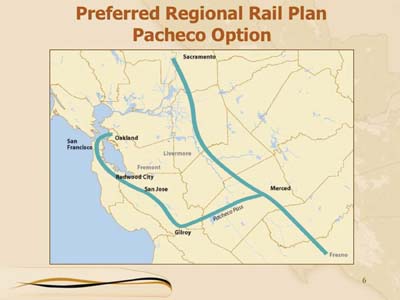Republicans regained a majority in the House of Representatives
in part by pledging to rein in stimulus spending by the Obama
administration
– and that could include high-speed rail.
Tim Sheehan
Republicans regained a majority in the House of Representatives in part by pledging to rein in stimulus spending by the Obama administration – and that could include high-speed rail.
One GOP leader’s promise to revisit the distribution of billions of dollars for high-speed rail has cast a shadow over California’s ambitious plan to begin construction of an 800-mile high-speed rail system somewhere in the San Joaquin Valley in 2012.
But newly elected Republican governors in Wisconsin, Ohio and Florida are opposed to high-speed rail in their states. That is raising cautious hope that more federal money will be left for California.
Amid the new political reality in Washington, experts say it’s too soon to know whether last week’s election results will benefit or derail California’s plan for trains that would travel between San Francisco and Los Angeles through the Valley.
So far, California has received the biggest share of federal funds of any state – more than $3 billion. And the federal government is requiring most of that money be used to design and build the first section of the project between Merced and Bakersfield. That is where the trains could reach their projected top speed of 220 mph.
Officials at the California High-Speed Rail Authority, the agency in charge of developing the system, are closely watching what other governors are saying and doing. Part of the rail authorities plans call for the route heading over the Pacheco Pass near San Benito and Santa Clara counties.
If states like Wisconsin or Florida reject federal funds, “we’re eager to compete for that money, if there’s an opportunity,” said Jeffrey Barker, the authority’s deputy director.
Barker said California did not receive all of the federal money for which it applied in 2009 and 2010, “so we know where we’ll put that money if we can get it.”
“Our position in California is to fight for as many federal dollars as possible, because we know those are job-creating dollars in the short term,” Barker said.
The state rail authority estimated that the system will create as many as 600,000 construction jobs, including up to 135,000 in the Valley, while the system is being built.
If some governors are indeed willing to give up their money, one rail expert said, California and other states would be wise to grab it while it’s still available.
“It’s always better when there’s less competition,” said Charles Banks, president of R.L. Banks & Associates, a Washington, D.C., consulting firm for high-speed rail projects.
“I don’t think California or any other state should do anything but redouble their efforts,” Banks added. “It’s hard to read the election returns nationally as [meaning] anything other than that federal money will be less in the future.”
That’s because a Republican majority in the House will have considerable influence on how future federal budgets are put together.
Rep. John Mica, a Florida Republican in line to become chairman of the House Transportation and Infrastructure Committee, said last week that he disagrees with how the Department of Transportation allocated about $10 billion for high-speed rail programs.
Without specifically criticizing any projects in an Associated Press interview, Mica complained that most of them weren’t true high-speed trains like systems in Europe and Asia. He also said that the Northeast is probably the only region in the United States with a population density great enough to financially support a high-speed rail network.
Mark Kadesh, a Washington, D.C.-based lobbyist for the California High-Speed Rail Authority, stressed that the key decisions still are months away. Mica himself, Kadesh observed, “has been a supporter of high-speed rail in the past.”
As chairman of the House Transportation and Infrastructure Committee, Mica will have a big say in writing a long-overdue transportation bill. That will authorize funding for high-speed rail projects; in addition, President Barack Obama will offer his own funding proposals in his Fiscal 2011 budget, to be released in February.
“The chairman and the House are going to have to figure out what they’ll support for high-speed rail and for highways,” Kadesh said, adding that, “the truth is, the San Francisco-to-L.A. rail route has a high amount of support in the administration and in the Congress.”
Mica isn’t the only key player to watch.
The next House majority whip, Rep. Kevin McCarthy of Bakersfield, represents a region that has been pushing hard for high-speed rail.
As third-highest House officer, McCarthy will be in a good position to advocate for causes he favors.
Last month, McCarthy joined other Kern County officials in voicing support for building a high-speed rail maintenance facility in Shafter.
And in the Senate, which narrowly remains under Democratic control, newly re-elected Sen. Barbara Boxer is slated to continue leading the Senate Environment and Public Works Committee. That puts her in a good position to retain high-speed rail projects in the big transportation authorization bill.
Barker won’t speculate on whether the House shift from Democratic to Republican control will mean more hurdles for California’s high-speed rail program.
“Before Tuesday’s election, we knew there would be a big challenge to secure the federal funding we need, and I don’t think that changes,” Barker said. “We need to work with Congress no matter who’s in charge, to show them the need and help identify how to fund it nationally.”
“What we learned from this election is how strongly people want to create jobs,” he added. “All of the legislators, whether they’re Republican or Democrat, understand that infrastructure investment is a great way to create jobs.”









